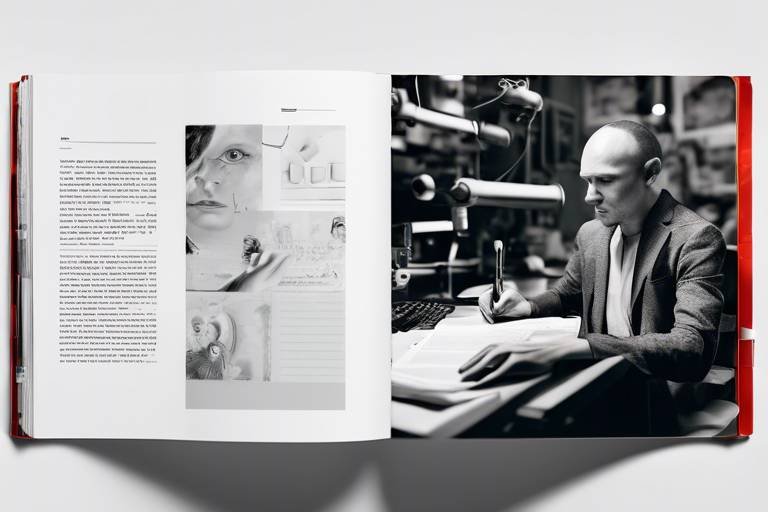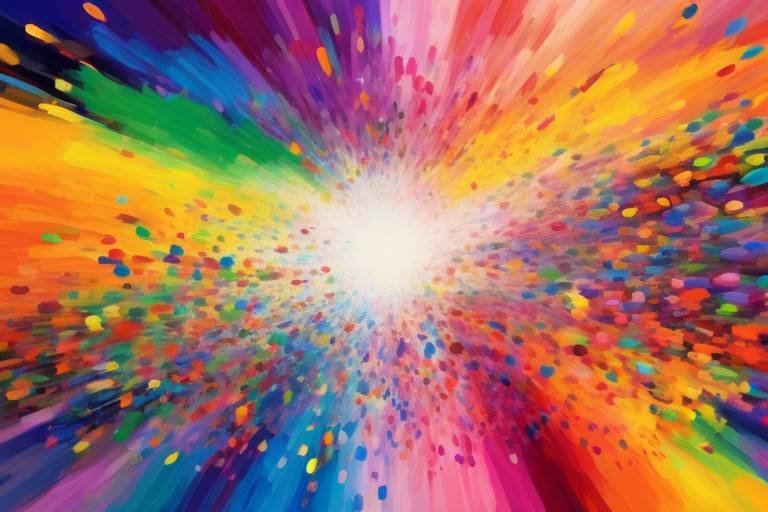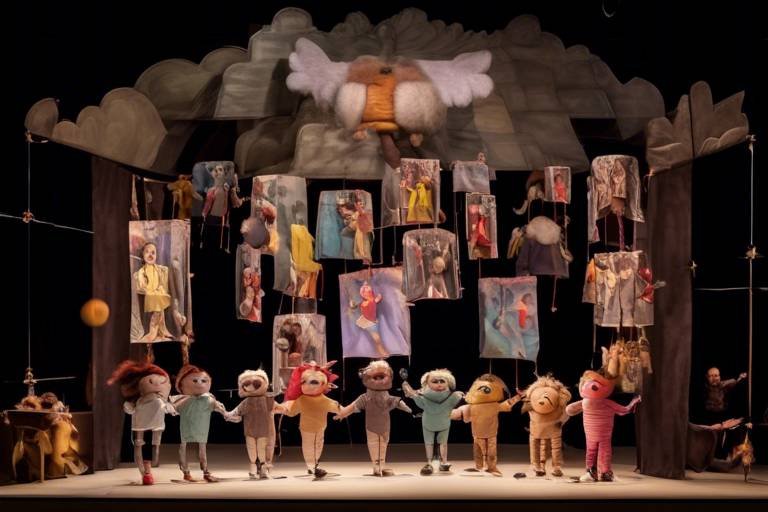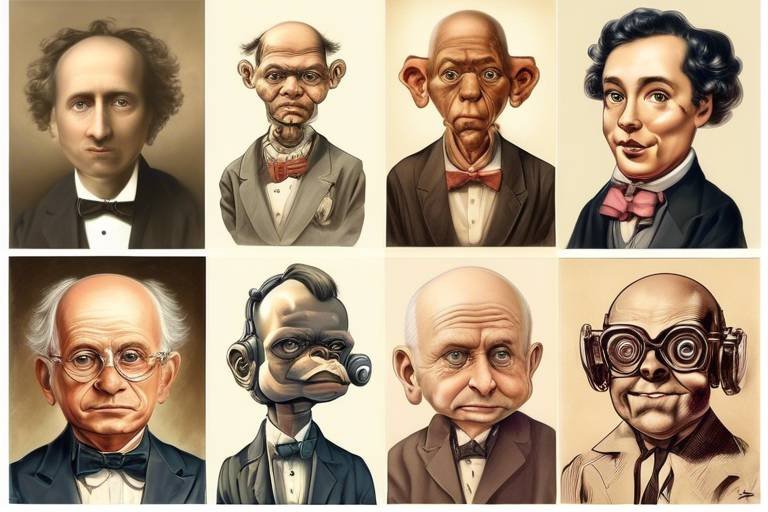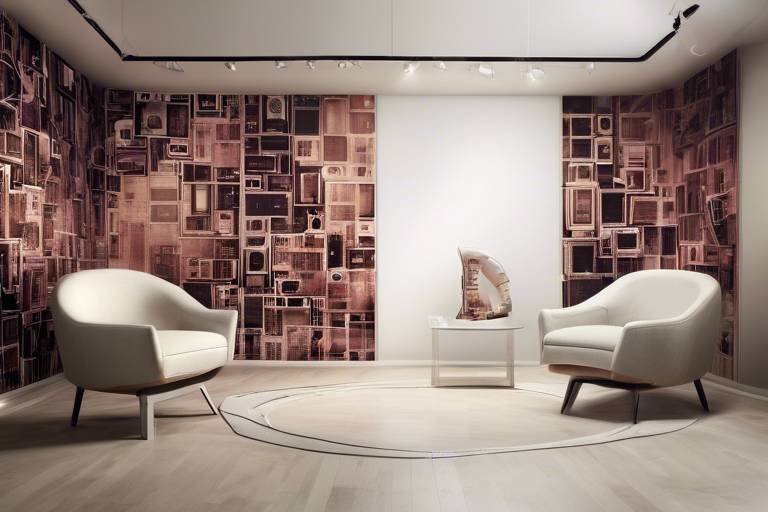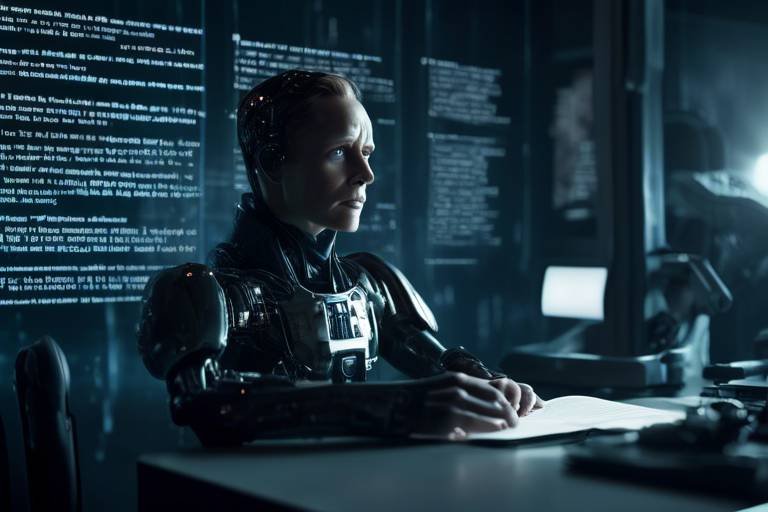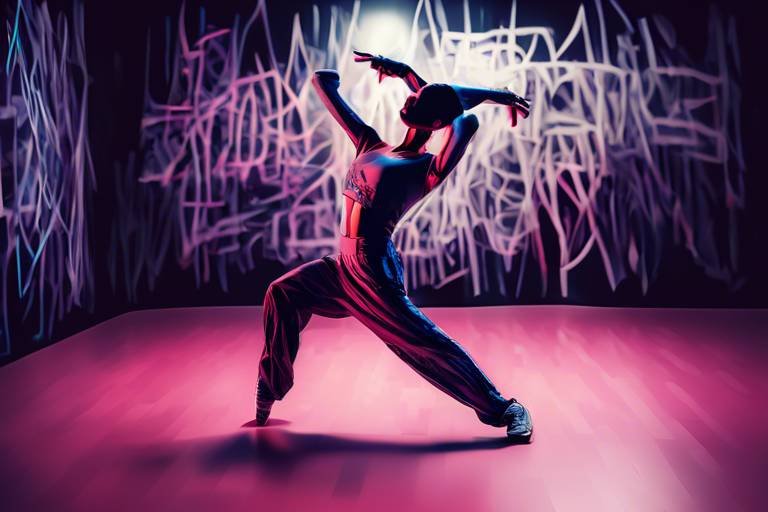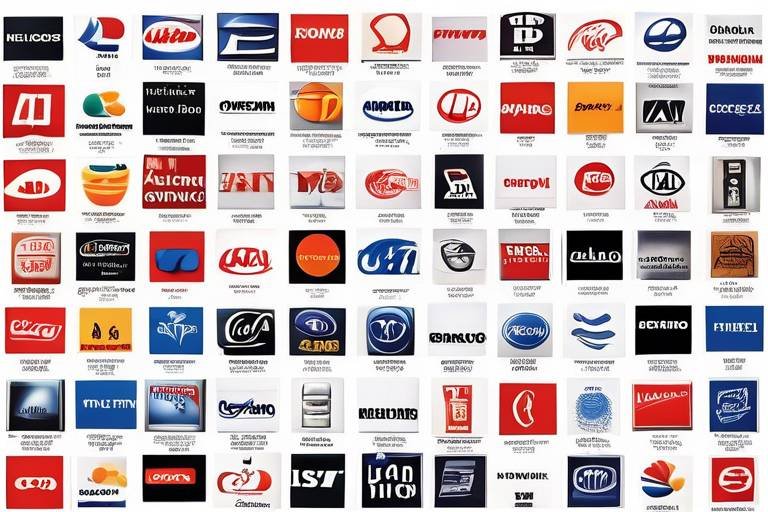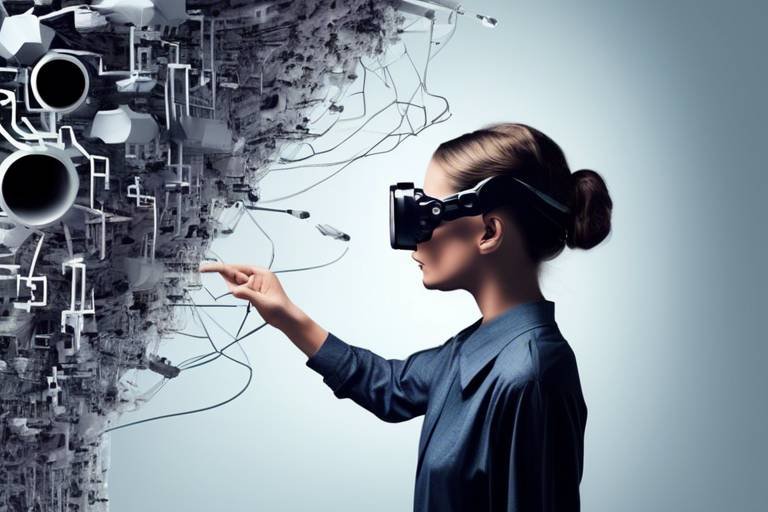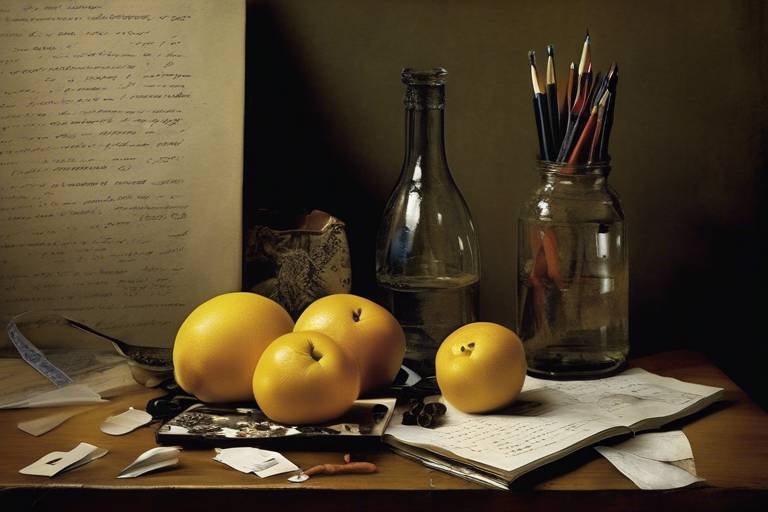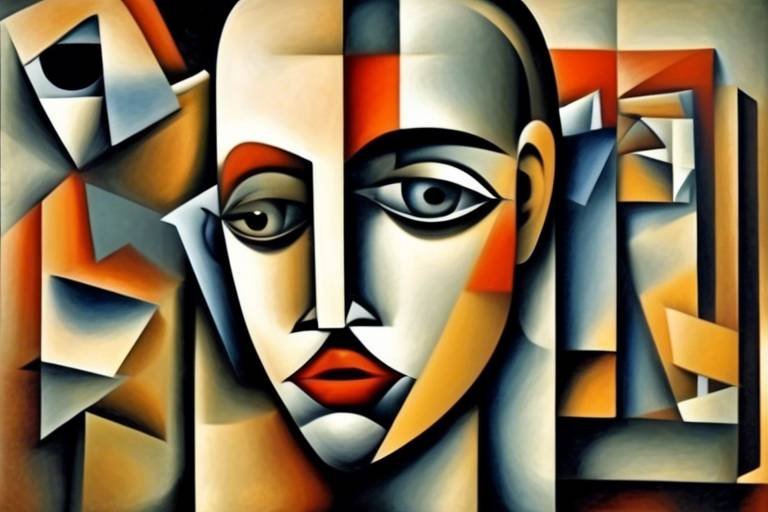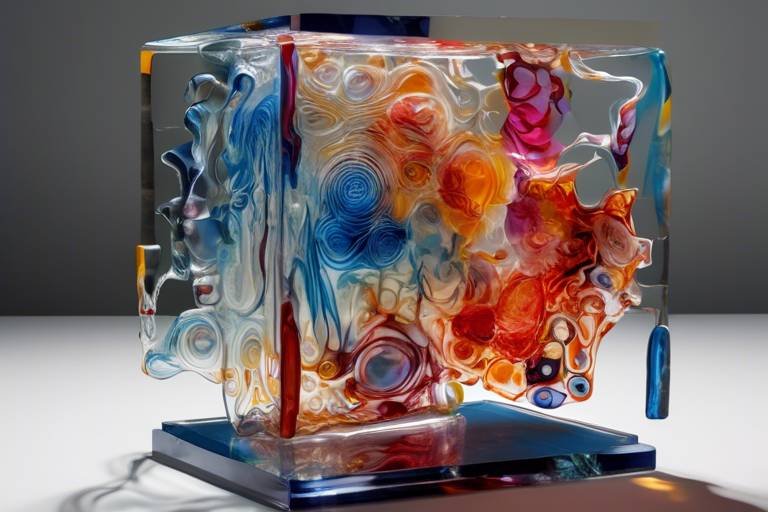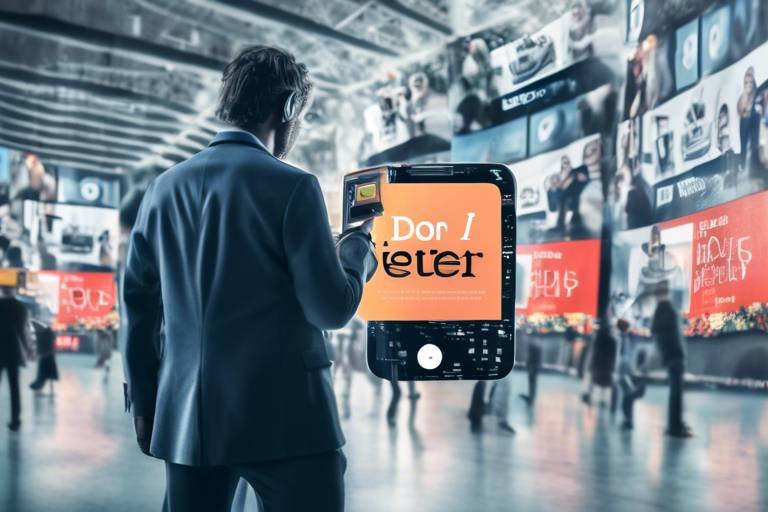Creative Diaries: Unleashing AI in Graphic Design
Graphic design has always been a fascinating blend of art and technology, but in recent years, it has undergone a **dramatic transformation**. With the rapid advancement of artificial intelligence (AI), the landscape of graphic design is evolving at an unprecedented pace. Imagine a world where your design ideas can be brought to life with just a few clicks, where creativity meets computational power, and where designers can focus more on innovation rather than repetitive tasks. This article will explore how AI is reshaping the graphic design industry, highlighting innovative tools, techniques, and the changing role of designers in this technology-driven landscape.
In the past, graphic design was often a labor-intensive process, requiring extensive hands-on skills and a deep understanding of traditional design principles. Designers relied on physical tools like pencils, brushes, and paper, spending hours, if not days, perfecting their craft. However, as digital technology began to emerge, designers started to embrace software that offered new possibilities. The transition from traditional methods to digital tools paved the way for the integration of AI technologies, which are now revolutionizing the way designs are created.
AI is not just a buzzword; it is a **game-changer**. With the rise of AI-powered tools, designers can now create stunning visuals more efficiently than ever before. Whether you are a seasoned professional or a budding artist, AI tools are making graphic design more accessible, allowing anyone to explore their creative potential. From automating mundane tasks to generating unique design solutions, AI is helping designers save time and enhance their creative workflows.
As we delve deeper into this article, we will uncover the various ways AI is being utilized in graphic design, from generative design techniques to enhancing user experiences. We will also discuss the evolving role of designers in an AI-driven world, emphasizing the importance of human creativity and critical thinking. So, buckle up as we embark on this exciting journey through the world of AI in graphic design!
The journey of graphic design is a fascinating one, marked by significant changes over the decades. In the early days, designers relied heavily on traditional methods, using physical materials to create their art. As technology advanced, the introduction of computers brought about a **revolution** in design practices. Software like Adobe Photoshop and Illustrator became staples in the designer's toolkit, allowing for greater flexibility and creativity.
Today, we find ourselves at the forefront of another monumental shift in graphic design, thanks to AI. This transition has not only changed the tools designers use but has also influenced their creative processes. With AI, designers can analyze vast amounts of data to understand trends and user preferences, enabling them to create more targeted and effective designs. This evolution is not just about tools; it's about redefining the entire creative process.
As we explore the realm of AI in graphic design, it’s essential to highlight some of the **cutting-edge tools** that are making waves in the industry. These AI-powered platforms are designed to streamline the design process, making it easier for designers to bring their ideas to life. Here are a few notable tools that are reshaping the graphic design landscape:
- Canva: A user-friendly design platform that incorporates AI features, allowing users to create stunning visuals effortlessly.
- Adobe Sensei: Adobe's AI engine that enhances creative workflows by automating repetitive tasks and providing smart recommendations.
- DeepArt: A tool that uses neural networks to transform photos into artwork, blending styles and creating unique visuals.
These tools not only save time but also inspire creativity by providing designers with new ways to experiment and innovate. With AI at their fingertips, designers can focus on what they do best—creating compelling and visually striking designs that resonate with audiences.
As we conclude our exploration of AI in graphic design, let's address some common questions that may arise:
- How does AI impact the role of graphic designers?
AI tools assist designers by automating repetitive tasks, allowing them to focus more on creative aspects. However, human intuition and creativity remain irreplaceable. - Are AI-generated designs as good as human-made ones?
While AI can produce impressive designs, the emotional depth and nuanced understanding of human experiences are aspects that AI cannot replicate. - What are the future trends in AI and graphic design?
We can expect continued advancements in AI technologies that will further enhance design capabilities, alongside an ongoing need for human creativity.

The Evolution of Graphic Design
Graphic design has undergone a remarkable transformation over the years, evolving from traditional methods rooted in manual artistry to a vibrant, technology-driven discipline. In the early days, graphic design was all about hand-drawn illustrations, typesetting, and painstakingly crafted layouts. Designers relied heavily on physical tools like pencils, ink, and paper, pouring their heart and soul into every piece. It was a time when creativity was bound by the limitations of materials and techniques.
As technology began to seep into the creative world, the introduction of computers revolutionized the graphic design landscape. The advent of digital tools in the late 20th century allowed designers to experiment and iterate in ways that were previously unimaginable. Software like Adobe Photoshop and Illustrator became essential, enabling designers to manipulate images and create complex graphics with ease. Suddenly, the design process became faster and more dynamic, opening up new avenues for creativity.
Fast forward to today, and we find ourselves in an era where artificial intelligence is making waves in graphic design. AI technologies are not just tools; they are partners in the creative process. Designers can now harness the power of algorithms to generate unique design solutions, analyze trends, and even automate repetitive tasks. This integration of AI has not only enhanced efficiency but has also challenged traditional notions of creativity. No longer is design solely the domain of human intuition; it now incorporates the analytical prowess of machines.
To illustrate this evolution, consider the following table that highlights the key milestones in graphic design:
| Era | Key Features |
|---|---|
| Pre-20th Century | Hand-drawn illustrations, manual typesetting, limited color palettes. |
| Late 20th Century | Introduction of computers, digital design software, rapid prototyping. |
| 21st Century | AI integration, generative design, data-driven decision-making. |
The journey of graphic design is a testament to the human spirit of innovation. Each leap forward has not only expanded the toolkit available to designers but has also redefined what it means to be a creative professional. As we embrace this new era of AI-powered design, one thing remains clear: the essence of graphic design lies in the ability to communicate ideas visually, a skill that will always require a human touch.
- How has technology changed graphic design?
Technology has streamlined the design process, allowing for faster iterations and more complex designs through digital tools. - What role does AI play in graphic design today?
AI assists in generating designs, automating tasks, and providing insights based on data analysis, enhancing creativity and efficiency. - Will AI replace graphic designers?
While AI can automate certain tasks, the unique creativity and intuition of human designers are irreplaceable and essential for innovative design.

AI Tools Revolutionizing Design
In today's fast-paced digital world, the landscape of graphic design is undergoing a remarkable transformation, thanks to the advent of AI-powered tools. These innovative technologies are not just enhancing traditional design methods; they are fundamentally reshaping the way designers approach their craft. Imagine a world where tedious tasks are automated, allowing creatives to focus on what they do best—dreaming up stunning visuals and captivating narratives. Sounds exciting, right? Well, that’s precisely what AI tools are bringing to the table!
From automated layout generation to advanced image editing, AI tools are making design more efficient and accessible than ever before. For instance, platforms like Canva and Adobe Spark leverage AI to suggest layouts based on user preferences, while tools like Daz 3D allow designers to create 3D models with just a few clicks. This means that even those who may not have extensive design training can produce professional-quality work. It’s like having a personal design assistant who knows your style and helps you bring your ideas to life!
One of the most exciting aspects of AI in design is Generative Design. This process uses algorithms to explore a vast range of design possibilities based on specific inputs. Designers can set parameters such as materials, manufacturing methods, and cost constraints, and the AI generates multiple design options that meet those criteria. It’s akin to having a brainstorming session with an infinite number of ideas at your fingertips. The result? Unique, innovative designs that might not have been conceived through traditional methods.
Moreover, AI tools are also enhancing the way we think about color theory. Choosing the right color palette can often feel like a daunting task, but AI simplifies this process. Tools like Adobe Color and Colormind analyze existing designs and trends to suggest harmonious color combinations that evoke specific emotions. This is particularly useful for branding projects, where color plays a crucial role in how a brand is perceived. With AI's assistance, designers can ensure their work resonates with the intended audience, creating a visual experience that is both impactful and memorable.
As we delve deeper into the realm of AI in graphic design, it’s essential to recognize that these tools are not here to replace human creativity; rather, they are here to enhance it. The true magic happens when designers embrace these technologies and integrate them into their workflow. By doing so, they can not only streamline their processes but also push the boundaries of creativity in ways they never thought possible.
In summary, the rise of AI tools in graphic design is revolutionizing the industry, making it more efficient, accessible, and innovative. Designers are no longer constrained by traditional methods; instead, they are empowered to explore new avenues of creativity and expression. As we look to the future, it’s clear that the synergy between human creativity and AI technology will continue to drive the evolution of graphic design, paving the way for exciting new possibilities.
- What is generative design?
Generative design is a design process that uses algorithms to generate a multitude of design options based on specified parameters, allowing for innovative solutions that may not be easily conceived through traditional methods. - How does AI improve color selection in graphic design?
AI tools analyze existing designs and trends to suggest harmonious color combinations, ensuring that the final product resonates emotionally with the audience. - Can AI replace graphic designers?
No, AI is designed to assist and enhance the work of graphic designers, not replace them. The creative intuition and critical thinking of a human designer remain irreplaceable.

Generative Design
Generative design is nothing short of a revolution in the world of graphic design. Imagine a scenario where a computer can take your ideas and transform them into a myriad of design possibilities, all while you sit back and sip your coffee. Sounds like magic, right? But this is the reality that generative design brings to the table. By leveraging the power of algorithms and artificial intelligence, designers can explore creative avenues that were previously unimaginable.
At its core, generative design utilizes computational algorithms to create unique design solutions. This approach allows designers to input parameters such as materials, manufacturing methods, and desired outcomes, and the software then generates a range of options that meet those criteria. It’s akin to having a creative partner that tirelessly works alongside you, offering suggestions and variations that you might not have considered. This collaborative effort between human creativity and machine efficiency is what makes generative design so powerful.
One of the most exciting aspects of generative design is its ability to produce unexpected results. Designers often find themselves surprised by the outcomes, leading to innovative solutions that could redefine a project. For instance, when designing a logo, a designer might input specific colors and themes, but the generative design tool could yield options that incorporate elements they hadn’t even thought of. This kind of creative synergy can truly elevate a project, making it stand out in a crowded marketplace.
Generative design isn’t just about aesthetics; it also plays a crucial role in functionality. For example, in branding projects, companies are increasingly turning to generative design to create distinctive logos that reflect their identity while remaining versatile across various platforms. The result? A visual identity that not only looks good but also resonates with the audience on multiple levels. This is particularly important in today’s fast-paced digital landscape, where brands must capture attention quickly and effectively.
Moreover, generative design enhances user experience by personalizing design elements based on user preferences and behaviors. Imagine a website that adapts its layout and color scheme based on the individual visitor’s history and interactions. This level of customization is made possible through generative design, which can analyze data and make real-time adjustments. By doing so, it ensures that users have a seamless and engaging experience, ultimately leading to higher satisfaction and loyalty.
In summary, generative design is not just a trend; it’s a transformative approach that is reshaping the graphic design landscape. As designers embrace these innovative tools, they can unlock new levels of creativity and efficiency, allowing them to focus on what they do best: creating impactful designs that resonate with their audience. The future of graphic design is bright, and generative design is at the forefront of this exciting evolution.
- What is generative design?
Generative design is a design process that uses algorithms and artificial intelligence to create a variety of design solutions based on input parameters set by the designer.
- How does generative design enhance creativity?
It allows designers to explore unexpected outcomes and variations, leading to innovative solutions they might not have considered on their own.
- Can generative design be used in branding?
Yes, many companies utilize generative design to create distinctive logos and visual identities that can adapt to different platforms and audiences.
- How does generative design improve user experience?
By personalizing design elements based on user data, generative design can enhance the overall user experience, making it more engaging and relevant.

Applications in Branding
In the fast-paced world of branding, standing out from the crowd is more crucial than ever. With the advent of AI, companies are now leveraging innovative technologies to craft unique identities that resonate with their target audience. Generative design, a fascinating application of AI, allows brands to create distinctive logos and visual identities that not only capture attention but also convey their core values and messages effectively.
Imagine a logo that evolves based on user feedback or market trends—this is the power of generative design. By utilizing algorithms, designers can produce multiple variations of a logo, each tailored to different demographics or trends. This method not only saves time but also enhances creativity, as designers can explore a plethora of options without the constraints of traditional design processes. For example, a tech startup might generate a series of logo concepts that reflect innovation and modernity, while a sustainable brand could focus on earthy tones and organic shapes, all generated through AI algorithms.
Moreover, AI tools can analyze vast amounts of data to determine which designs are most likely to resonate with specific audiences. This data-driven approach helps brands make informed decisions, ensuring that their visual identity aligns with consumer preferences. For instance, a brand targeting millennials may opt for vibrant colors and playful typography, while a luxury brand might choose a minimalist approach with elegant fonts and a subdued color palette.
But it doesn't stop there! AI can also assist in the creation of cohesive branding across various platforms. By generating design elements that maintain visual consistency—such as color schemes, typography, and imagery—brands can ensure that their messaging is unified, whether on social media, websites, or print materials. This level of coherence not only strengthens brand recognition but also builds trust with consumers.
In summary, the applications of AI in branding are not just about aesthetics; they are about creating a meaningful connection with the audience. As brands continue to embrace these technologies, we can expect to see even more innovative and personalized branding solutions that capture the essence of what they stand for. The future of branding is here, and it's powered by AI!
- What is generative design? Generative design is an AI-driven process that uses algorithms to create design solutions based on specific parameters, allowing for a wide range of creative options.
- How does AI enhance branding? AI enhances branding by providing data-driven insights that help create visually appealing and relevant brand identities tailored to target audiences.
- Can AI replace human designers? While AI can assist in the design process, it cannot replace the creativity, intuition, and critical thinking skills that human designers bring to the table.
- What tools can I use for AI-driven branding? There are several AI-powered design tools available, such as Adobe Sensei, Canva, and Looka, which can help streamline the branding process.

Enhancing User Experience
In today's fast-paced digital world, user experience (UX) has become a critical factor in the success of any design project. With the integration of AI technologies, designers are now equipped with tools that not only streamline the design process but also enhance the overall user experience. Imagine walking into a store where every product is tailored to your preferences; that’s the kind of personalized experience AI can create in the digital realm.
AI can analyze vast amounts of user data, allowing designers to understand and anticipate user needs and behaviors. By leveraging this data, designers can create interfaces that are not only visually appealing but also intuitive and user-friendly. For instance, AI can help in identifying the most effective layout for a website based on user interaction patterns. This means that instead of guessing what works, designers can rely on data-driven insights to make informed decisions.
Moreover, AI tools can assist in creating adaptive designs that change based on user preferences. Imagine a website that alters its color scheme and layout depending on the time of day or the user's mood. This level of personalization is not just a gimmick; it can significantly improve user satisfaction and engagement. By tailoring experiences to individual users, designers can foster a deeper connection between the brand and its audience.
Consider the role of AI in content recommendation systems. These systems analyze user behavior to suggest relevant content, products, or services. For example, streaming platforms like Netflix use AI algorithms to recommend shows and movies based on your viewing history. This not only enhances user experience but also keeps users engaged for longer periods. As a result, designers must now think beyond aesthetics and focus on creating experiences that resonate with users on a personal level.
In addition, AI can optimize the accessibility of designs, making them usable for a broader audience, including those with disabilities. Tools powered by AI can automatically adjust text size, contrast, and layout to meet accessibility standards. This ensures that every user, regardless of their abilities, can navigate and enjoy the digital experience. Embracing accessibility is not just a legal obligation; it’s a moral one, and AI is paving the way for more inclusive design practices.
In conclusion, the integration of AI into graphic design is revolutionizing how designers approach user experience. By harnessing the power of AI, designers can create more personalized, engaging, and accessible experiences. The future of design is not just about making things look good; it’s about making them work better for the user. As we move forward, the collaboration between human creativity and AI technology will undoubtedly lead to unprecedented innovations in enhancing user experience.
- How does AI improve user experience in graphic design?
AI enhances user experience by analyzing user data to create personalized and adaptive designs that meet individual needs. - Can AI replace graphic designers?
No, while AI can assist in the design process, the creativity and critical thinking of human designers remain irreplaceable. - What role does accessibility play in user experience?
Accessibility ensures that all users, including those with disabilities, can navigate and enjoy digital content, which is vital for a positive user experience. - Are there any tools that help with AI-driven design?
Yes, there are numerous AI-powered design tools available, such as Adobe Sensei and Canva’s Magic Resize, that help streamline the design process.

AI and Color Theory
Color is not just a visual element; it's a powerful tool that evokes emotions, influences perceptions, and can even drive consumer behavior. In the world of graphic design, understanding color theory is paramount. But with the advent of artificial intelligence, the way designers approach color selection has undergone a significant transformation. Imagine having a virtual assistant that not only understands the basics of color theory but can also analyze trends, user preferences, and even psychological impacts of colors in real-time. This is precisely what AI brings to the table.
AI-powered tools are now capable of suggesting color palettes that resonate with specific target audiences. For instance, by analyzing vast amounts of data from social media, e-commerce platforms, and design databases, these tools can identify which colors are trending and why. They can also provide insights into how certain colors can influence user emotions and behaviors, allowing designers to make informed decisions that align with their project goals. This capability is akin to having a crystal ball that reveals what colors will capture attention and drive engagement.
One of the most fascinating aspects of AI in color theory is its ability to create harmonious color combinations. Traditionally, designers relied on their intuition and knowledge of color relationships—such as complementary, analogous, and triadic schemes. However, AI can analyze these relationships at a much deeper level and generate combinations that might not be immediately apparent to the human eye. For example, an AI tool can suggest a color palette that includes a primary color, a secondary color, and an accent color that not only works well together but also enhances the overall visual appeal of the design.
Furthermore, AI can adapt color suggestions based on user interactions. Imagine a website that changes its color scheme depending on the time of day or the user's mood, detected through their browsing behavior. This level of personalization is becoming increasingly possible thanks to AI algorithms that learn from user data. Designers can leverage these insights to create dynamic and engaging experiences that feel tailored to each user, ultimately leading to increased satisfaction and loyalty.
To illustrate the impact of AI on color selection in graphic design, consider the following table that compares traditional methods with AI-driven approaches:
| Aspect | Traditional Methods | AI-Driven Approaches |
|---|---|---|
| Color Selection | Based on designer's intuition and experience | Data-driven suggestions based on trends and user preferences |
| Color Harmony | Manual creation of color schemes | Automated generation of harmonious combinations |
| Personalization | Static color choices | Dynamic adjustments based on user behavior |
As we delve deeper into the realm of AI and color theory, it becomes clear that these technologies are not meant to replace designers but rather to enhance their capabilities. By integrating AI into their workflows, designers can focus more on the creative aspects of their projects while relying on AI to handle the more analytical components. This collaboration between human creativity and machine intelligence is paving the way for innovative design solutions that were previously unimaginable.
In conclusion, AI's role in color theory is a game-changer for graphic designers. It empowers them to create visually stunning and emotionally resonant designs that cater to the needs of their audience. As we continue to explore the intersection of technology and creativity, one thing is certain: the future of graphic design will be as colorful as the palettes we choose.
- How does AI improve color selection in design?
AI analyzes data to suggest color palettes that resonate with target audiences, ensuring designs are both appealing and effective. - Can AI create unique color combinations?
Yes, AI can generate harmonious color schemes that might not be immediately obvious, enhancing the overall design. - Is AI replacing human designers?
No, AI is a tool that enhances the designer's capabilities, allowing them to focus more on creativity while handling analytical tasks.

The Designer's Role in an AI-Driven World
As we navigate through the ever-evolving landscape of design, the role of graphic designers is undergoing a significant transformation, largely driven by the advent of artificial intelligence (AI). Gone are the days when designers solely relied on their artistic instincts and traditional tools. Today, they find themselves in a fascinating partnership with technology, where creativity meets computational prowess. This shift not only enhances the efficiency of the design process but also opens up a new realm of possibilities for innovation.
In an AI-driven world, designers are no longer just creators; they are also curators of experience. With AI tools capable of analyzing user data, designers can tailor their creations to meet specific audience needs. Imagine a world where your design adapts in real-time based on user interaction! This capability allows designers to focus on the more nuanced aspects of their work, such as storytelling and emotional resonance, while AI handles the repetitive tasks. It’s like having a creative assistant that never tires, always ready to optimize designs based on the latest trends and user feedback.
However, this shift raises an important question: What does it mean to be a designer in this new era? The answer lies in the balance between human intuition and machine efficiency. Designers must harness the power of AI while maintaining their unique creative vision. This involves understanding how to leverage AI tools effectively, integrating them into their workflow without losing the essence of what makes their designs stand out. In essence, designers must evolve into strategic thinkers, capable of blending technology with artistry.
To illustrate this evolution, let’s consider a few key areas where the designer's role is changing:
- Creative Problem Solving: Designers are now tasked with solving complex problems using AI-generated insights. This requires a deep understanding of both design principles and AI capabilities.
- User-Centric Design: With AI's ability to analyze user behavior, designers can create more personalized experiences, ensuring that their work resonates with the target audience.
- Collaboration with AI: Rather than viewing AI as a competitor, designers are learning to collaborate with it, using AI tools to enhance their creative process.
As we look to the future, it’s clear that the role of designers will continue to evolve. They will become more like conductors of creativity, orchestrating the interplay between human imagination and AI efficiency. This collaboration will not only lead to more innovative designs but also to a deeper understanding of the audience’s needs and preferences.
In conclusion, the designer's role in an AI-driven world is not just about adapting to new tools but embracing a mindset of continuous learning and collaboration. As technology advances, so too must the creativity and adaptability of designers. This synergy between human and machine will pave the way for groundbreaking design solutions that were once thought impossible.
Q1: Will AI replace graphic designers?
A1: While AI is transforming the design process, it is unlikely to replace graphic designers. Instead, it enhances their capabilities, allowing them to focus on more creative and strategic aspects of design.
Q2: How can designers effectively collaborate with AI?
A2: Designers can collaborate with AI by using tools that analyze data, generate design options, and automate repetitive tasks, thereby freeing up time for more creative work.
Q3: What skills should designers develop in an AI-driven landscape?
A3: Designers should focus on developing skills in data analysis, user experience design, and a strong understanding of AI tools to remain competitive in the field.

Collaboration Between Human and AI
The partnership between human creativity and artificial intelligence is becoming a cornerstone of modern graphic design. Imagine a world where designers are no longer bogged down by repetitive tasks, allowing them to focus on what they do best: creating. This collaboration is akin to a dance, where both partners bring their unique strengths to the floor, resulting in a performance that is greater than the sum of its parts.
AI can handle the heavy lifting, processing vast amounts of data to generate design options that a human might not even consider. For instance, tools like Adobe's Sensei utilize machine learning algorithms to analyze design trends and suggest layouts, color palettes, and typography that resonate with the target audience. This not only speeds up the design process but also enhances the quality of the output. Designers can then refine these AI-generated concepts, injecting their personal touch and ensuring that the final product aligns with the client's vision.
One fascinating example of this collaboration can be seen in the creation of marketing materials. Imagine a designer tasked with creating a series of ads for a new product launch. By leveraging AI tools, the designer can quickly generate multiple versions of the ad, each tailored for different demographics. The AI analyzes user data to suggest variations that might appeal to specific groups, such as age, location, or interests. This way, the designer can focus on the creative aspects, such as storytelling and emotional appeal, while the AI handles the data-driven decisions.
Moreover, this synergy is not just limited to aesthetics; it extends to functionality as well. AI can help in predicting user engagement and preferences, allowing designers to create more effective user interfaces. For example, by analyzing user interaction data, AI can suggest design changes that enhance usability, making the user experience smoother and more intuitive. This is where the real magic happens—when human intuition meets machine precision.
However, it's essential to understand that while AI can significantly enhance the design process, it cannot replace the human element. Designers bring empathy, cultural understanding, and emotional intelligence to their work—qualities that AI, no matter how advanced, cannot replicate. This is why the best results come from a collaborative approach where designers and AI work hand in hand. The designer's role evolves into that of a curator and strategist, using AI as a powerful tool to amplify their creative vision.
As we look to the future, the collaboration between human designers and AI will likely deepen. With advancements in machine learning and natural language processing, we can expect even more sophisticated AI tools that will further enhance this partnership. Designers who embrace this change will not only stay relevant but will also lead the charge in creating innovative and impactful designs that resonate with audiences on a deeper level.
- What are the benefits of using AI in graphic design? AI can streamline the design process, enhance creativity, and provide data-driven insights that help designers make informed decisions.
- Will AI replace graphic designers? No, AI is a tool that enhances the work of graphic designers, allowing them to focus on creativity and strategy rather than repetitive tasks.
- How can designers collaborate with AI? Designers can use AI tools to generate design options, analyze user data, and predict engagement, allowing for a more efficient and effective design process.
- What skills will designers need in an AI-driven world? Designers will need to develop skills in technology, data analysis, and critical thinking, alongside their traditional creative skills.

Future Trends in Graphic Design
As we gaze into the crystal ball of graphic design, it’s clear that the landscape is shifting dramatically, thanks to the relentless march of technology. The integration of AI is not just a passing trend; it’s a revolution that promises to redefine the very essence of how we create and interact with visual content. Imagine a world where designers are not just creators but also curators of AI-generated art, blending their unique vision with the computational prowess of machines. This fusion is paving the way for several exciting trends that are set to shape the future of graphic design.
First and foremost, we can expect to see a surge in personalization within design. With AI's ability to analyze user data and preferences, graphic designers will be equipped to create tailored experiences that resonate on a deeper level with audiences. Think about it: instead of a one-size-fits-all approach, every piece of design could be uniquely crafted to meet the desires and needs of individual users. This shift will not only enhance user engagement but will also foster a stronger emotional connection between brands and their customers.
Another trend on the horizon is the rise of augmented reality (AR) and virtual reality (VR) in graphic design. These technologies are no longer confined to the realms of gaming and entertainment; they are becoming essential tools for designers. Imagine walking into a store and being able to see how a piece of furniture would look in your living room through your smartphone. Designers will need to adapt their skills to create immersive experiences that captivate users in ways traditional designs cannot. This shift towards experiential design will require a blend of creativity and technical know-how.
Moreover, the concept of collaborative design will gain traction. As AI tools become more sophisticated, designers will find themselves working alongside intelligent systems that can provide suggestions, generate ideas, and even execute designs. This collaboration will not replace the human touch but rather enhance it, allowing designers to focus on the more intricate aspects of their work while AI handles repetitive tasks. The result? A more efficient design process that encourages innovation and creativity.
Additionally, sustainability is becoming a crucial consideration in design. Future designers will be challenged to create visually stunning work while also being mindful of their environmental impact. With AI's ability to analyze materials and processes, designers can explore sustainable alternatives that reduce waste and promote eco-friendly practices. This trend towards sustainability will not only appeal to environmentally conscious consumers but will also set a new standard in the industry.
To summarize, the future of graphic design is bright and filled with possibilities. As designers embrace AI and other emerging technologies, they will unlock new levels of creativity and efficiency. The key to thriving in this evolving landscape lies in adaptability and a willingness to learn. Designers who can harness the power of AI while maintaining their unique creative voices will undoubtedly lead the charge into this exciting new era.
- What role will AI play in graphic design in the future? AI will assist designers by automating repetitive tasks, providing personalized design suggestions, and enabling the creation of immersive experiences.
- How can designers prepare for the integration of AI in their work? Designers should focus on learning new technologies, enhancing their creative skills, and embracing a mindset of collaboration with AI tools.
- Will AI replace graphic designers? No, AI is meant to enhance the work of graphic designers, allowing them to focus on creativity and innovation rather than mundane tasks.
- What are some sustainable practices in graphic design? Designers can use eco-friendly materials, minimize waste in their processes, and create designs that promote sustainability.
Frequently Asked Questions
- What is the impact of AI on graphic design?
AI is revolutionizing graphic design by streamlining processes, enhancing creativity, and enabling designers to focus on more complex tasks. It helps automate repetitive tasks, allowing designers to spend more time on the creative aspects of their work.
- How have graphic design tools evolved with AI?
Graphic design tools have become more sophisticated with AI integration. Tools now offer features like generative design, which allows algorithms to create unique design solutions, and AI-driven color theory assistance, which helps in choosing harmonious color palettes.
- What is generative design?
Generative design is a process that uses algorithms to generate a wide range of design options based on specific parameters set by the designer. This approach combines creativity with computational power, resulting in innovative and unique design solutions.
- How does AI enhance user experience in design?
AI enhances user experience by personalizing design elements. It analyzes user preferences and behaviors to create designs that resonate more with individual users, making interfaces more intuitive and engaging.
- What role does color theory play in AI-driven design?
Color theory is crucial in design, and AI assists designers in selecting color combinations that evoke specific emotions and ensure visual harmony. AI tools can suggest palettes based on current trends and psychological impacts of colors.
- How is the role of graphic designers changing with AI?
The role of graphic designers is evolving to include more strategic thinking and creativity as they collaborate with AI. While AI handles technical aspects, designers are focusing on conceptualizing ideas and ensuring the emotional connection of designs.
- Can designers and AI collaborate effectively?
Absolutely! Successful collaborations between designers and AI have been seen in various projects. Designers leverage AI's efficiency while infusing their intuition and creativity, resulting in outstanding and innovative designs.
- What are some future trends in graphic design influenced by AI?
Future trends may include more advanced AI tools that can predict design needs, increased personalization in user interfaces, and a greater focus on sustainability in design practices. However, the need for human creativity will always remain paramount.

